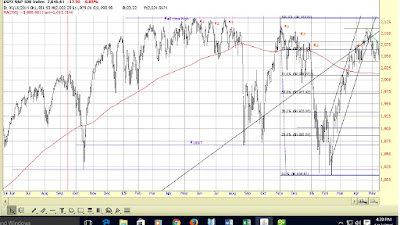The Morning Call
5/31/16
The
Market
Technical
Tuesday Morning Chartology
The
S&P soared last week, cutting through that very short term downtrend like a
hot knife through butter. We now await a
challenge of the upper boundary of its short term trading range.
The
long Treasury continues to struggle in a fairly tight trading range. With all the talk of an increasing Fed Funds
rate, you would think that it would have moved to the downside.
GLD
took out its short term uptrend with little difficulty, is now challenging its
100 day moving average and is about to challenge the newly reset lower boundary
of a short term trading range. If both
those challenges are successful, the run is GLD may be over.
The
VIX is making another run at the lower boundary of its short term trading
range. If it can successfully challenge
it, we could be in for a fun summer.
Otherwise, this recent rally may come of a screeching halt.
Fundamental
Headlines
US
economic news slipped back into the negative column last week: above estimates:
April housing starts, weekly mortgage and purchase applications, the April
trade balance, April durable goods orders and weekly jobless claims; below
estimates: May Markit manufacturing and services PMI’s, month to date retail
chain store sales, the May Richmond and Kansas City Fed manufacturing indices,
revised first quarter GDP and May consumer sentiment; in line with estimates:
April durable goods orders, ex transportation and first quarter corporate
profits. The primary indicators were
ever so slightly positive: April housing starts (+), April durable goods orders
(+) though April durable goods, ex transportation was in line, and revised
first quarter GDP (-). Overall, I am
going to rate this a neutral week, making the current score: in the last 37
weeks, nine have been positive to upbeat, twenty six negative and two neutral.
That
makes three weeks in a row that the numbers have been neutral to positive. That is hardly a trend but it is a sufficient
enough divergence from the overall pattern of the last nine months to beg the
question of whether or not the US economy has ceased weakening. The answer is that it is too soon to tell but
the yellow is now flashing. However, if
the economy is starting to gain some traction, that would clearly be a big plus.
But it would no way suggest that the US economy is about to return to its
historical secular growth rate. It
remains burdened by too much government spending, too many taxes, too much
regulation and a Fed that is way too impressed with its ability to control the
economy.
***overnight,
May EU inflation remained negative (-0.1%) while April Japanese factory output,
household spending and job availability were better than expected.
Of
course, last week’s big news was the apparent hawkish turn of the Fed,
including Yellen, implying a June or July rate increase. And that seemed to be the driving force
behind the Market moonshot. The
reasoning for all this jigginess, as I read the Market gurus, is that the Fed
is moving now because the economy is so awesome but in case it’s not, the Fed will
have more room to cut rates---which seems to lack some logic. First of all, while the last three weeks of
data have been decent and three weeks is at least a semblance of trend, I am
not sure that sufficient to declare the economy on an upward trajectory strong
enough (even in the Fed’s model) to warrant a rate hike. Second, if things are so peachy, why already
start worrying about the economy rolling over?
I
suspect that the real reason was that the Fed, knowing that it has itself in a
box, tested the waters again on a rate hike and when the Market response was
favorable (since the Market has been the only piece of data dependency upon
which the Fed has relied), everyone on the FOMC went all in for an increase in
rates.
All
this nonsense aside, my thesis remains that QE did little to help the economy
so its absence will do little harm; however, QE was the primary fuel for the
gross mispricing and misallocation of assets, hence, its absence will likely have
a profound impact on asset pricing.
Thoughts
from Sam Zell (medium):
Warning
from the yield curve (medium):
Subscriber Alert
The
price of FMC Inc. (FMC) has risen above the upper boundary of its Buy Value
Range and, hence, is being Removed from the Dividend Growth Buy List.
The
price of AmeriGas Ptrs (APU) has risen above the upper boundary of its Buy
Value Range and, hence, is being Removed from the High Yield Buy List.
Investing for Survival
What
is risk?
News on Stocks in Our Portfolios
Revenue of $7.57B
(+3.7% Y/Y) beats by $80M
Revenue of C$6.59B
(+10.9% Y/Y) beats by C$150M.
Economics
This Week’s Data
April
personal income rose 0.4%, in line; personal spending was up 1.0% versus expectations
of up 0.7%; the core PCE price index was up 0.2%, in line.
Other
China
getting more aggressive in yuan devaluation (medium):
The
failure of negative interest rates (medium):
Quote
of the day (short):
Here
we go again---free money to those who can’t pay it back (medium):
Politics
Domestic
International War Against Radical
Islam
Visit Investing
for Survival’s website (http://investingforsurvival.com/home)
to learn more about our Investment Strategy, Prices Disciplines and Subscriber
Service.












